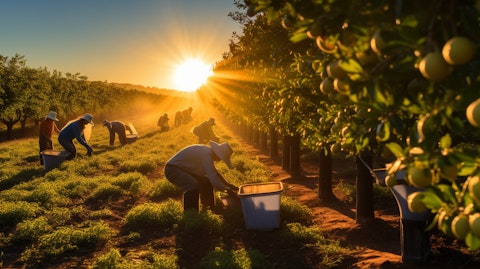Dole plc (NYSE:DOLE) Q1 2025 Earnings Call Transcript May 12, 2025
Dole plc misses on earnings expectations. Reported EPS is $0.35 EPS, expectations were $0.39.
Operator: Welcome to the Dole plc First Quarter 2025 Earnings Conference Call and Webcast. Today’s conference is being broadcast live over the internet and is also being recorded for playback purposes. Currently, all participants are in a listen-only mode. After the speaker’s presentation, there will be a question-and-answer session. For opening remarks and introductions, I would like to turn the call over to the Head of Investor Relations with Dole plc, James O’Regan.
James O’Regan: Thank you. Welcome everybody and thank you for taking the time to join our first quarter 2025 earnings conference call and webcast. Joining me on the call today is our Chief Executive Officer, Rory Byrne; our Chief Operating Officer, Johan Linden; and our Chief Financial Officer, Jacinta Devine. During this call, we’ll be referring to presentation slides and supplemental remarks, and these, along with our earnings release and other related materials, are available on the Investor Relations section of Dole plc website. Please note, our remarks today will include certain forward-looking statements within the provisions of the Federal Security Safe Harbor Law. These reflect circumstances at the time they are made and the company expressly disclaims any obligation to update or revise any forward-looking statements.
Actual results or outcomes may differ materially from those that may be expressed or implied due to a wide range of factors, including those set forth in our SEC filings and press releases. Information regarding the use of non-GAAP financial measures may be found in our press release, which also includes a reconciliation to the most comparable GAAP measures. With that, I’m pleased to turn today’s call over to Rory.
Rory Byrne: Thank you, James. Welcome everybody and thank you for joining us today as we discuss our results in the first quarter of 2025. So, turning firstly to the highlights of the first quarter, following a very strong result in 2024 we are pleased to report another good performance in the first quarter of 2025, exceeding our own expectations. On a like-for-like basis, group revenue increased by 4.2% to $2.1 billion, and adjusted EBITDA decreased 2% to $104.8 million. The first quarter saw solid performances in both of our diversified fresh produce segments, which helped offset the anticipated headwind in our fresh fruit segment, which was impacted by tropical storm Sarah late last year. Adjusted net income came in at $33.1 million, and adjusted EPS was $0.35 per share, down from $0.43 in Q1 of 2024, primarily due to the decrease in adjusted EBITDA.
We are pleased to increase our dividend by 6.25% to $0.085 per share for the first quarter. This is our first dividend increase since starting dividend payments back in 2021, and demonstrates our confidence in the long-term growth potential for our business. Post-quarter end, we were very pleased to complete the $1.2 billion refinancing of a credit facility at favorable rates relative to market conditions. This financing strengthens the financial position of Dole, and provides enhanced financial flexibility to support our growth and initiatives. Turning now to the operational review, and starting with fresh fruit on Slide 6. So fresh fruit delivered a robust performance in the first quarter with adjusted EBITDA of $63.3 million, exceeding our own expectations, taking into account the anticipated impact of Tropical Storm Sarah.
Firstly, looking at North America, our underlying operations performed very well, with good volume growth in bananas, as well as positive developments in both pineapples and plantains. Profitability was somewhat held back by the anticipated higher sourcing costs following the impact of Tropical Storm Sarah. We also experienced higher shipping costs as we completed scheduled dry dockings, and managed another temporary operational challenges that have now been resolved. We are addressing production challenges following Tropical Storm Sarah, and we expect to face some headwinds in this regard for the remainder of the financial year. However, our production and sourcing teams are doing an excellent job mitigating this, and are working diligently to manage the reinvestment and rehabilitation process, while also ensuring we continue to fully service our cost to our customers.
We aim to return to near full production of the affected farms by early 2026. Turning to the European market, we saw a stable performance overall in the first quarter, with continued good volume growth in bananas, as well as better performance in pineapples, offsetting more challenging pricing in bananas, which was impacted by the weaker Europe in the first quarter of 2025 compared to the prior year. Looking ahead to the rest of the year, we continue to see robust demand, and we expect this to continue over the course of the full year. We feel very positive that the industry supply and demand for bananas and pineapples are well balanced. Additionally, strength in Europe could potentially serve as a positive tailwind for the remainder of the year.
Moving on to our diversified EMEA segment, this segment has had a positive start to the year, delivering very strong like-for-like growth in the first quarter to reach an adjusted EBITDA of $27.7 million, aided by both strong revenues and some margin expansion. On a reported basis, this good growth was curtailed somewhat by the weaker Euro in the first quarter of 2025 compared to the first quarter of 2024. However, with the material strengthening of the Euro in recent weeks, this dynamic should become a tailwind for our reported numbers over the course of the year if current rates are maintained. Within the segment, we are seeing some differing dynamics across travel goods starting the year before outperforming others and generally better sales into retail compared to our food service and wholesale channels.
Overall, this segment continues to benefit from the significant diversification and is performing in a very positive way. We continue to accelerate our strength in this segment and our focus on identifying and executing upon both internal and external investment opportunities. We are confident these continuous efforts will drive continued solid growth as the year progresses. Our Diversified America segment delivered a strong first quarter result with double-digit growth on a like-for-like basis in EBITDA, taking into account the disposal of progressive projects in late Q1 2024. This robust performance was driven by good results in the North American market, with only modest declines in our Southern Hemisphere export businesses, despite experiencing more normal supply and market conditions compared to 2024.
Notably, the previous year benefited from an exceptionally strong season for Chilean cherries. As we look further into 2025, we believe our businesses both on the export side and in North America are well positioned. We will continue to stay highly attentive to the evolving dynamics in international trade and prepare to react appropriately. Turning to fresh vegetables, as noted in our recent earnings calls, we continue to work on delivering the best strategic outcome for our vegetable business and this process remains ongoing. Operationally, following a robust turnaround in 2024, the business faced weaker fresh produce markets against a particularly strong comparative period in early 2024. However, this was offset by a stable performance in our value-added business, where we see clear signs of strengthening our competitiveness, characterized by improved delivery quality, lower underlying costs and an increased focus on innovation.
With that, I’ll hand you over to Jacinta to give the financial review for the first quarter.

Jacinta Devine: Thank you, Rory and good day everyone. Turning firstly to the group results on Slide 11, we are pleased to have delivered another good performance for the first quarter of this financial year. Revenue of $2.1 billion was 1% lower on a reported basis, primarily due to lower revenue in Diversified Americas following the disposal of progressive produce last year, as well as a $21 million unfavorable impact from foreign currency translation. Excluding these impacts, on a like-for-like basis, revenue increased 4.2% with good organic growth seen in fresh fruits and diversified fresh produce in the year. Net income in the first quarter was $44.2 million, a $21.3 million year-on-year decrease. However, the prior year had the benefit of a net exceptional gain of $37.3 million related to the progressive produce disposal.
Also, there was an $8 million decrease in other income due to unrealized FX losses on foreign currency borrowings. Offsetting these items was an increase in equity method investments related to a non-cash gain on an M&A transaction, as well as a higher net income relating to our discontinued operations. Similarly, to year-end we recorded a non-cash accounting adjustment to the carrying value of discontinued operations in Q1, with the adjustment this quarter largely offsetting the cessation of depreciation and amortization that occurs under discontinued operations accounting. Now, looking at the non-GAAP performance measures, adjusted EBITDA decreased by approximately $5 million, primarily due to a decrease in fresh fruit and a decrease in diversified fresh produce in America and the rest of the world due to the progressive produce disposal.
On a like-for-like basis, the decrease was $2.2 million. Adjusted net income decreased $7.5 million, predominantly due to the decrease in adjusted EBITDA, as well as higher depreciation expense. Adjusted diluted EPS was $0.35 compared to $0.43 in the prior year. Now, returning to the divisional update for our continuing operations, starting with fresh fruit on Slide 13. Revenue increased 6.5%, primarily due to higher worldwide volumes of bananas sold, as well as higher worldwide pricing of pineapples and bananas, partially offsetting this with the lower worldwide volumes of pineapples and plantains. Adjusted EBITDA decreased $6.1 million, primarily driven by higher anticipated fruit sourcing costs, following the impact of Tropical Storm Sarah in Honduras, as well as higher shipping costs due to completion of scheduled dry docking and the impact of an operational disruption for one of our vessels servicing the North American market.
These challenges were partially offset by good underlying performance in bananas on a worldwide basis, as well as improved performance in pineapples on a worldwide basis. The diversified EMEA segments delivered another strong result in the first quarter of 2025. Reported revenue increased 4.5%, primarily due to strong performance in the UK, Spain, and the Netherlands. This was partially offset by an FX headwind of $19.4 million and a net negative impact from M&A of $10.5 million. Excluding these impacts, on a like-for-like basis, revenue increased 8% or $68.4 million. Adjusted EBITDA increased 6.6% or $1.7 million, primarily driven by increases in the UK, Spain and the Netherlands. This was partially offset by lower earnings in Germany and an unfavorable impact of foreign currency translation of $0.7 million.
On a like-for-like basis, adjusted EBITDA increased 9.4% or $2.5 million. Now, turning to diversified fresh produce Americas and the rest of the world, as in previous quarters, reported revenue in Diversified Americas was impacted by a progressive produce disposal last year. On a like-for-like basis, revenue declined by 6.8%. This decrease was primarily attributable to lower export pricing for key Southern Hemisphere products, particularly cherries, as well as declines in the North American market due to reduced pricing for grapes and lower volumes of avocados. Adjusted EBITDA decreased 0.9 million, primarily driven by the disposal of progressive produce. However, on a like-for-like basis, adjusted EBITDA increased by 10.4% or $1.5 million.
This growth was primarily driven by strong performance in the North American market in kiwis, citrus and avocados. However, these gains were partially offset by declines on the Southern Hemisphere export side in cherries and grapes, as well as declines in berries in the North American market. Now turning to Slide 16 to focus on capital allocation on our balance sheet. Firstly, as mentioned by Rory a notice in the press release issued on May 1st we were very pleased to announce the successful completion of a 1.2 billion refinance of our corporate credit facilities. The new syndicated credit facilities consist of a 600 million multi-currency five-year revolving credit facility, a 250 million five-year term loan A and a 350 million seven-year farm credit term loan replacing our existing RCF, TLA and TLB.
Looking at interest expense this has continued to decrease due to lower debt levels as well as lower base rates and was 17.2 million in the first quarter. Under the assumption that base rates will remain broadly stable in 2025 and not assuming any exception on cash proceeds we continue to expect further interest expense to be approximately 70 million. Cash capital expenditure from continuing operations was 52.8 million a quarter including the buyout of two vessel finance cases of 36 million that were already reflected within net debt at year end and discussed in our previous earnings calls. The remaining 16.8 million included expenditure on vessel dry dockings, farming investments, efficiency projects in our warehouses, and ongoing investments in IT and logistics assets.
In line with our usual seasonal working capital trends and accentuated by the timing of the cherry season we saw working capital outflow in the first quarter. The combination of these factors resulted in pre-cash flow from continuing operations being an outflow of 131.6 million. As in previous years we expect to see this unwind as the year progresses. This outflow was the primary driver behind the net increase in net leverage to 1.9 times at the end of March. Asset sales in the quarter were 4.8 million, this primarily related to the sale of actively marketed plant in Hawaii. As mentioned by Rory we are pleased to declare an $0.085 dividend for the first quarter representing a 6.25% increase from our last declared dividend. Now I’ll hand you back to Rory who will give an update on our full year outlook.
Rory Byrne: Thanks Jacinta. Well we’re pleased with the performance in Q1 delivering a result which is ahead of our own expectations. This result gives us a strong foundation for the rest of the year in a very dynamic macroeconomic environment. Like most multinational businesses we continue to monitor the evolving macro international economic scenario. We do believe that our industry is a good example of the benefits of international trade providing year-round healthy products for our consumers and are confident the existing trade deals will continue on acceptable terms. Short-term disruptions may arise across a range of areas such as foreign exchange rates, labor markets, or supply chains. A good start to the year along with our resilient and diverse business model gives us confidence in our ability to navigate the challenges of the current volatile economic environment.
Consequently, we are pleased to provide our guidance upwards and are now targeting full year adjusted EBITDA of at least $380 million. Turning to investments over the course of the year we continue to expect as a baseline to have a maintenance level of CAPEX from continuing operations broadly in line with our depreciation expense of approximately $100 million. Additionally, we also anticipate some increased CAPEX spend over the course of the year related to our reinvestments in Honduras albeit significantly supported by insurance proceeds. We remain focused on exploring a range of development opportunities through both internal and external investment which we believe can further strengthen our business and drive growth for the years ahead.
I want to conclude by once again thanking all our outstanding people across the group for their ongoing commitment and dedication to driving Dole plc forward. Our experienced and knowledgeable team continue to serve us very well. Additionally, we really appreciate all our essential partners, suppliers, customers, and all other stakeholders for their continued support. And with that I’ll hand the call back to the operator to open the line for questions.
Operator: Thank you. [Operator Instructions]. Your first question comes from Christopher Barnes with Deutsche Bank. Your line is open.
Q&A Session
Follow Dole Food Co Inc (NYSE:DOLE)
Follow Dole Food Co Inc (NYSE:DOLE)
Receive real-time insider trading and news alerts
Christopher Barnes: Hi. Good morning and good afternoon. I just wanted to follow up on the EBITDA guidance. You’re now setting a floor at the upper end of the prior range. I’m curious how much of that raise would you attribute to better underlying performance in the quarter, perhaps higher expectations over the balance of the year versus inorganic factors like the expected foreign exchange translation tailwinds at current rates? And then just related to that, does this updated outlook embed current tariffs in place in the U.S. market and is there any way to quantify what those tariff impacts might be on a gross basis and what actions you’re taking to mitigate those? Thanks.
Rory Byrne: Well thank you Christopher. So a range of interesting questions there. Yeah, I mean obviously doing forecasting in the current environment is a little bit challenging. So we’ve put all the factors into the mix including the current known scenario regarding tariffs and their impact, the likely impact on our business and that’s our best shot at the target for the full year. A big element of that is obviously down to doing a little bit better in Q1 than we had anticipated, particularly with the headwinds that we had highlighted on Tropical Storm Sarah. And we have made some assumption that the translation over the remaining quarters given the Euro exchange rate to the dollar is facilitating a better translation on reporting in dollars. So to sum up all those factors, we are moving a little bit above our previous range. So I think putting it all together we’re feeling positive about the balance of the year.
Christopher Barnes: Very good. And then just a follow-up around the fresh vegetables business. I understand you continue to evaluate potential exit options but I mean it’s been over a year since the deal with Fresh Express was terminated. How do you guard against the risk that underlying business performance deteriorates as you continue to market that business and I guess like are you still committed to exiting the business or might it make more sense just to retain it, I mean performance was very strong last year and you’re up against a tough compare this quarter but it seems like you’re still net ahead, so I’m just curious how you’re thinking about that business going forward? Thanks.
Rory Byrne: Yeah, it’s a good question Christopher and clearly we would have liked to have strategic certainty around this at an earlier stage than we have done. But the process is complex and we are trying to find a good strategic answer for all of the stakeholders, the employees, the management, customers, suppliers, the long-term future of the business. So putting the new deals together has been quite complex. I think continuing to disclose it as discontinued operations probably highlights where our position on it is. We think there is an appropriate exit. It will be a little bit different to the Fresh Express deal and we’re still working on it. We’re very actively working on that and I think it’ll be a good outcome for all of the stakeholders if we can get to that position.
We’ve worked very hard as well as to try and avoid any impact on the ongoing business. It’s not perfect having it in discontinued operations but there are a lot of other competing businesses who are either private equity owned who are also for sale or will at some point in time be for sale. So it’s a little bit the world we live in but businesses do change hands. You do have temporary owners and private equity owners and things like that so it can be challenging to manage in that environment and our management team has done well in working around those challenges.
Christopher Barnes: Very helpful context. Thanks. I’ll pass it on.
Rory Byrne: Thank you, Christopher.
Operator: The next question comes from Gary Martin with Davy. Your line is open.
Gary Martin: Hi, Rory, Jacinta, and Johan. Congrats on a strong start to the year. Just a few questions from my side just to kick things off. So you completed your refi post quarter. I think you noted that a driver there is more flexibility for growth initiatives. It’d just be good to get a run through of kind of how you envisage capital allocation policy on a go forward basis be it internal or external opportunities? Thanks.
Rory Byrne: Thanks, Gary. I think as always we keep all of the capital allocation alternatives on the table. A big strategic issue at first is really getting to the end of the vegetable current process and whether it’s keep or sale will have an impact on our future capital availability, our focus of our future capital. I think as well getting the facilities renewed which we just recently announced was helpful to give us the basis and having those facilities in place for the long term is a very good outcome and the terms negotiated with the finance team I think were more than satisfactory. We continue to look at acquisitions with the internal corporate finance department. We look at a lot of companies that are in different geographies whether it’s in the U.S. or in Europe.
There are a number of PE funds, for example, coming to their end of their life cycle and still some challenges around the price expectations of the private sector versus the public sector. We’ve seen some changes in the market. Greenyard, for example, being taken private at a decent premium to its quoted price. The dividend as well, you’ll have seen, Gary, we’ve pushed up the dividends of 6.25% so we’re in line with the long-term policy in total projects and try to build steadily over the years on the dividends. Then we’ve got a lot of internal development projects that we’re doing a lot of work on at the moment. In our fresh food division, we’re particularly focused on developing category-flat plantains and doing some extra production ourselves in two joint ventures.
We’re looking at some of our lines and we’re expanding on some of our other JVs, particularly in our Alpaca JV in Chile. We have a number of projects in Northern Europe that can be very interesting but it’s a lot of work to get them to a conclusion on that. If we can bring this conclusion, it could be good internal organic growth in terms of reinvesting, particularly in automation technology. Then around the business, we’ve got smaller but important add-on CAPEX projects and that can be expanding our facilities capacity in Ireland or in Spain. We’re doing well in France in terms of building up our business, utilizing some facilities in the port of CEPI in the South of France. I think it can be good. Again, all of the options are on the table.
We are still a little bit conditioned by the outcome of the fresh vegetable division and the strategic outcome there but it’s an ongoing process.
Gary Martin: That’s a pretty good color. Maybe just on the operational side, it was a particularly standout performance just on diversified Americas and the rest of the world in terms of the like-for-like EBITDA. I think it’d be good just to get a better understanding of just the various components that drove that like-for-like EBITDA piece, just given I think revenues on a like-to-like basis for BAC. It’s entirely mixed from the North American basket of goods point of view. Is that what drove the profit performance in the rest of the world and the Americas? Thanks.
Rory Byrne: Yeah, I think we called out earlier that our distribution and handling businesses in North America had a very strong first quarter. Our export businesses out of South America, in particular Chile, had a more normal market year. We did have an exceptional 2024, particularly in cherries in that division. It was back to a more normal year but no particular negatives. Again, I think it’s well balanced there to look at and align with our own assessment of what market conditions might have been. So, it’s reasonably positive for the rest of the year.
Gary Martin: Okay. And then maybe just one final one, a bit of an anorak one, just on your CAPEX guidance. You’ve retained the 100 million, but just in terms of some of that additional incremental CAPEX that might be required for reinvestment in Honduras following the tropical storm, would it be possible just to get a bit of a quantum on how much that is above the insurance proceeds? Thanks.
Rory Byrne: It’s not a huge amount, Gary, but something in the order of $10 million to $12 million. But we’re hoping that that will bring with it some incremental EBITDA. We’re going to do a little bit in terms of improving hopefully the yields, improving the — protections for the longer term as well. But it’s not a huge amount of money, $10 million to $12 million.
Gary Martin: Excellent. It’s really good color. I’ll pass it on. Thanks.
Operator: This concludes the question-and-answer session. I’ll turn the call to Rory Byrne for closing remarks.
Rory Byrne: Thank you. Well, I think we’re pleased that we’ve delivered another good quarter. We’ve been competent enough to upgrade the target to at least $380 million of targeted EBITDA for the full year. Increased the dividend by 6.25% to take it up to $0.085 a quarter. We’ve made some very good progress as well on a number of strategic projects. So lots of macroeconomic challenges out there, but we believe we’re very well positioned to navigate our way through them successfully. So thank you all very much for joining us today.
Operator: This concludes today’s conference call and webcast. Thank you for joining. You may now disconnect.
Follow Dole Food Co Inc (NYSE:DOLE)
Follow Dole Food Co Inc (NYSE:DOLE)
Receive real-time insider trading and news alerts




